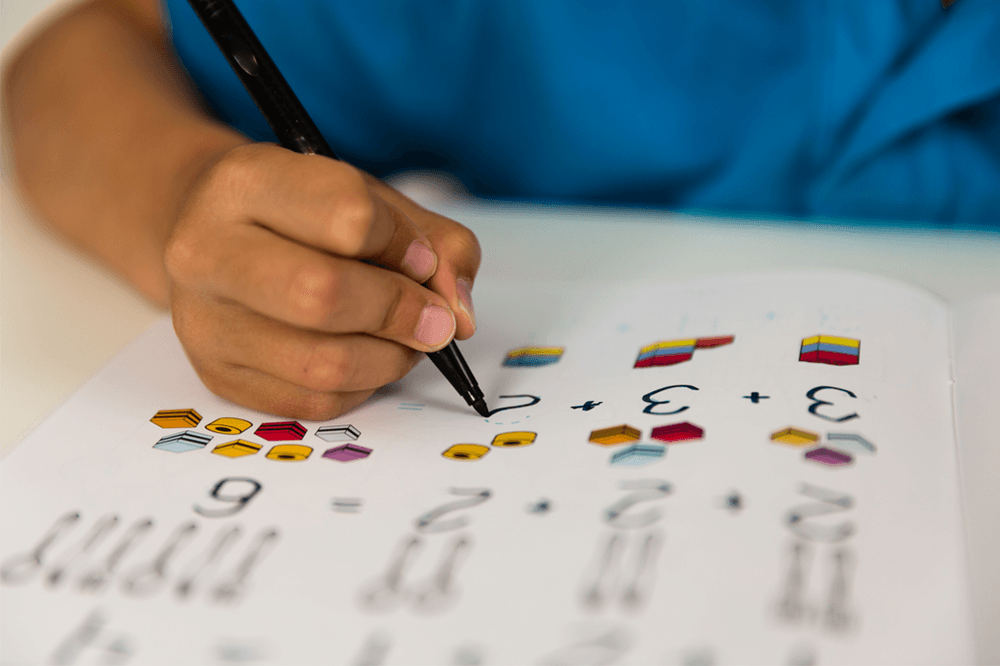

Last Updated on February 25, 2022
When I was beginning to learn how to play guitar, I remember proudly telling my dad that I had learned how to play a C chord.
My always supportive dad was equally as excited as I had been and asked me to show to him.
I tried… and the sound that came out was awful and screechy.
“You were close, but you want to make sure your finger on the B-string is at the first fret,” my dad encouraged. “Do you know why?”
Why? Because that’s where the picture shows to play it?
I thought I learned how to play C-chord because of a picture I studied. Truthfully, I didn’t understand the music theory behind it at all.
The memory has stuck with me as it helped me realize that learning and understanding are not synonymous.
This is true in all areas of learning and skill development: hobbies, sports, school…
So, when your child takes time to ‘learn’ a lesson, do they truly understand concepts, methods, and theories?
I’m sharing parenting skills tips on ways that you can work with your child to help them understand lessons. This prevents failing by setting them for learning success!
To your child, learning and understanding probably don’t seem like two different concepts.
But when they use the two words in a sentence, the context is quite different.
“I learned the Pythagorean Theorem in class today.”
Your child likely means that their teacher taught the formula. Their teacher probably started to explain the math theory, but the biggest take-away of the lesson: a2 + b2 = c2.
“My teacher taught Pythagorean Theorem, and I understand it.”
By using the word ‘understand,’ the context hints that your child can do more than spit out a formula.
It’s the ability to explain why the Pythagorean Theorem is a2 + b2 = c2.
It’s the ability to use it to answer different types of questions.
This gets into the heart of the difference between learning and understanding.
Learning is often process-oriented. It could be simply learning or memorizing facts or procedures.
Learning is processing the rules of the games.
On the other hand, understanding requires deeper thought and applying different contexts to those rules.
You can learn how to drive a car by studying manuals and taking a written driver’s test. But have you reached that deeper thoughtfulness that shows you understand driving?
One rule in the driver’s book: for every 10 mph of speed, the following distance should be one car length.
It’s an important rule to know, but why does it exist?
There are many factors to consider, like tire friction or road conditions should you need to suddenly stop.
And how and why do rain and snow affect this rule?
When it comes to understanding, you need to be able to analyze, manipulate, and synthesize facts and data. Understanding is “the ability to think and act flexibly with what one knows.”
So, for your child, think of learning and understanding as a two-step process.
First, your child needs to learn facts and steps.
Second, your child needs to work through different problems to develop a strong comprehension of the material.
As you work with your child to enhance their learning experiences, make sure you focus on both learning and understanding!
One way to do this with math is by tackling many different problem types. Critical thinking questions are awesome for ensuring your child really understands various topics!
Take multiplication for example. First, your child needs to develop fact fluency by learning basic multiplication tables.
Then they need to dwell in that problem space. It’s not just learning a fact and moving forward. Your child needs to try and work through a variety of related problems – especially ones that require using analytical and critical thinking skills when solving.
One of the big reasons teachers provide critical thinking questions is because they want to see how your child can synthesize and interpret facts. It demonstrates their true understanding and mastery of material when they can solve these types of problems.
Be sure to give your child exposure and practice with a variety of problem types. Enhance their learning experiences as much as possible to ensure that they aren’t just learning, but rather understanding the material.
Have you ever asked your child what they learned in school, and they replied, “I don’t know… stuff?”
Or does your child complain that school is boring or hard?
How their teacher teaches the lesson may be one reason your child zones out in class or has trouble understanding the material.
Your child has a particular learning style that they respond best to. Presenting lessons or activities with the style your child learns best with leads to a highly impactful learning experience!

Your child’s teacher likely tries to incorporate at least two instructions methods into their lessons.
It may be difficult for the teacher to tie in all of the methods into one lesson successfully (after all, there are eight learning styles!)
Take the time to understand what type of learner your child is. You can then work with them outside of the classroom to provide additional impactful learning experiences.
For example, if your child is a spatial learner, then they can create study charts or watch video tutorials to help cement what they learned in class that day. If your child is a musical learner, they can create new lyrics relating to a concept they learned and sing along to the tune of their favorite song!
Check out more on how to incorporate different styles of learning with these recommended teaching strategies and ideas! You can also ask your child’s teacher for recommendations on activities or assignments to foster a greater understanding of the material.
How do soccer players improve their penalty kicks?
Practice.
How does a pianist improve their speed and timing when playing scales?
Practice.
There’s a reason you’re told to practice and that, “Practice makes perfect,” when learning and developing a skill.
By practicing, you have the specific goal of improving performance. Practice and drills (and working with a coach) help train muscles and improve performance.
So, when it comes to academics, spending 45 minutes in school “learning” a lesson likely isn’t enough. Giving practice over time helps build a better understanding.
For students, there must be a clear distinction between repetition and deliberate practice.
When it comes to learning, repetition would be sitting down and having your child work through the 9 times tables over and over and over.
These are your typical drills or rote memorization methods.

On the other hand, deliberate practice is a style of practice that focuses on building skills that can be used in more complex types of problems later on.
It’s practicing the 9 times tables with the intention to use them to solve word problems.
Deliberate practice involves using existing knowledge to build on skills and incorporating review. This is like spiral learning, as you circle back to previous knowledge when you advance to more complex concepts.
So, don’t focus on only rote practice or memorization when providing learning and practice opportunities for your child!
Instead, make sure your child’s practice builds skills that help with more complex problem-solving questions and strategies.
Provide opportunities to solve a variety of problem types and always incorporate reviews to ensure your child doesn’t forget what they had learned.
There are many resources available – from workbooks to online websites – so that you can provide additional learning opportunities at home. Parenting blogs or Pinterest are also a great way of finding fun learning activities and projects!
When you were in school, did your teachers frequently remind the class not to wait until the night before to study for a test?
They wanted to make sure you didn’t procrastinate or cram, which is an ineffective study method and often results in a failing grade! (Check out more from the BBC on cramming for tests and why it isn’t good.)
Your child may start hearing not to cram from their teachers, but you also spend time working with your child on ways to effectively study.
This includes learning to organize both their time and study topics carefully.
First, work with your child to schedule a designated study and review time. Setting aside daily study time over a week is much better than waiting last minute and cramming!
Next, help your child identify the specific areas that they should study.
Should your child spend an equal amount of time studying every study guide question and topic?
No… not necessarily.
Instead, help them learn how to prioritize topics. They should focus on reviewing topics or questions that they find to be difficult.
A certain level of stress is good and leads to learning and growth. Without the right management or tools, though, stress could negatively affect your child’s emotional or mental state. As a result, stress or anxiety could then affect their academic performance.
Working with your child to create an organized study plan is one way of outlining the steps needed for performance success. Laying out an action plan gives the reassurance that success is achievable.
Additionally, there are other things that you can do to help your child get ready for test day – like developing a healthy mindset!
Exercise, a healthy diet, and modeling positive self-care habits can help your child reduce negative stress.
Also, make sure your child rests up the night before a big test. No late-night cramming!
You can check out more student stress management tips here.
After that big school quiz or test is over, you should then work with your child to review their performance.
This is a critical step in the learning process and needed for your child to make improvements.
If your child fails, it provides an opportunity for them to identify the areas that still need improvement to accelerate their learning outcomes. And if your child receives an A, still spend time reflecting on what worked out well during their prep and review!
The greatest performers, artists, and athletes train and work with a coach or instructor. They understand that another person can evaluate and critique their skills and offer timely feedback, suggestions, and assistance to improve.
When it comes to academics, even A-students hire coaches or math tutors to help them maximize their learning potential.
While your child can practice independently, receiving feedback helps them understand how to consistently improve and sharpen their skills.
It may be difficult for your child to examine their own proficiencies and performance. It’s something that is difficult for some adults to do too!

Hiring a coach, like a Thinkster Math tutor, ensures your child has someone dedicated to determining pinpoint specific skills that they can improve even more.
Our tutors also help in other areas too! Perhaps you want your child to focus on critical thinking problems. Doing so can help your child get into an Ivy League school or elite college and become highly successful.
Or, maybe your child plans to participate in a competitive math competition, like Math Kangaroo or Math Olympiad and wants to start prepping.
Their Thinkster tutor develops a learning plan and hand-selects assignments for your child. They give your child practice, daily assignment feedback, and hold one-on-one tutoring sessions for additional support.
This combo keeps your child’s skills sharp so that they continue to perform their best academically!
Take the time to make sure your child understands the material and that they can think and act flexibly.
When your child can answer a variety of question types relations to a topic, that’s when their true understanding and mastery shine!
Here are our five recommended parenting skills tips on how to enhance your child’s learning and understanding:
A coach or math tutor can help ensure your child understands what they learn in school, then remembers and builds upon those skills!
Thinkster Math tutors help students with a variety of math and life skills — from analytical and thinking skills to communication and organizational skills. Your child works with their very own personal Thinkster tutor, who helps maximize their learning and performance potential!
Learn more about our math tutors and get matched to an awesome tutor today.


